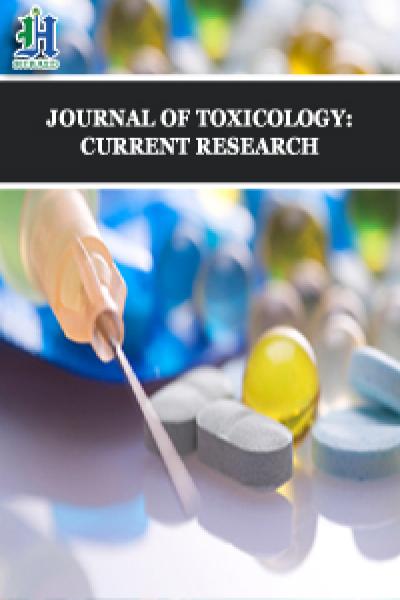
Envenomings Caused by Venomous Animals in Roraima: A Neglected Health Problem in the Brazil’s Northernmost State
*Corresponding Author(s):
Manuela Berto PuccaMedical School, Federal University Of Roraima, Boa Vista, Brazil
Tel:+55 4581924482,
Email:manu.pucca@ufrr.br
Abstract
Keywords
Amazon region; Epidemiological report; Envenoming; Roraima; Venomous animals
INTRODUCTION
In Brazil, despite the magnitude regarding the incidence of the venomous animals’ accidents, there is no uniformity of them through the regions [5]. While North and Central-West regions present snakebite prevalence, in the Northeast and Southeast regions scorpion stings prevailed [6,7]. On the other hand, in the South region, spiders are responsible for the highest number of accidents [5]. These geographic variations reflect the different degrees of human occupation in each region, the ecological imbalance caused by disordered urban growth, and the particular habitat that the animal can be adapted (e.g Tityus serrulatus scorpion demonstrated easy adaptation with high proliferation in most of Brazilian urban areas) [8-10]. It is important to note that only after June 1985 (during a high crisis and low production of antivenoms in the country), the notification of accidents with snakes became mandatory in the country. Later (1988), reporting scorpionism and araneism also became mandatory, which results in the National Program for Control Accidents by Venomous Animals (Programa Nacional de Controle de Acidentes por Animais Peçonhentos) [11].
The state of Roraima is the Brazil’s Northernmost state, presenting a typical vegetation of Amazon rainforest, besides being able to encompass favorable climatic conditions (equatorial and tropical) to shelter a wide biodiversity in almost all its territory, similar to the other Brazilian states of the North region [5,12,13]. Together, all these conditions possibly justify why the Amazon region presents the highest incidence of snakebites. Interestingly, the Amazon stable temperature during all the year (average of 27ºC) present relevant effect upon the reproduction of reptilians based on the inability of keeping themselves warm [14,15].
Despite the long history and high prevalence of accidents with venomous animals in Brazil, there are still few epidemiological studies regarding envenomings in the country [14,16], especially in the state of Roraima. Although underreported accidents are a problem in all Brazil, Roraima can be highlighted due to the scarcity of research investments and high number of Indians (more than 40% of the state is considered Indian areas), which potentiate underreporting data. Thus, the real statistics that provide a complete understanding of the current picture of the venomous animals’ accidents in Roraima is inconsistent and underestimated. In this sense, the present study describes an epidemiological analysis of venomous animals’ accidents occurred in the Roraima state.
MATERIALS AND METHODS
Data was obtained using Tabwin32 (version 4.14) and statistical analyzes were performed to verify the normal distribution (Shapiro Wilk's test) and homogeneity (Levene and Brown-Forsythe test) of the results, followed by parametric tests (in the presence of these conditions) or non-parametric tests (in the absence of these conditions).
Comparison between the different victims’ age groups of accidents caused by venomous animals, different species of animals responsible for the accidents, and number of accidents caused by the different snake genus were performed by One-way of Analysis of Variance (ANOVA) followed by Tukey or Kruskal-Wallis test. The difference between the occurrence of accidents by venomous animals between the female and male patients was evaluated by Student's t-test for independent samples. Possible association between the type of accident and the time for the therapeutic intervention, as well as between the type of accident and the severity of the envenoming was evaluated by the Chi-Square or Fisher's Exact test. Statistical analysis was performed using the Excel Software (Microsoft Office 2013, Redmond, WA, USA), Graph Pad Prism 5.0 (La Jolla, San Diego, CA, USA), or Statistica 12.0 software (StatSoft). Statistical significance level was set at 5% (p< 0.05).
RESULTS

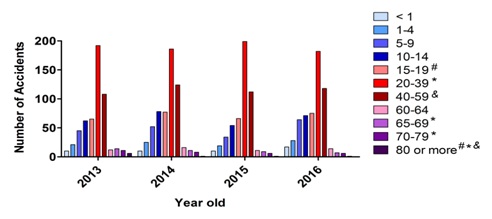
|
Roraima Municipalities |
2013 |
2014 |
2015 |
2016 |
Total |
|
Alto Alegre |
95 |
108 |
115 |
116 |
434 |
|
Amajari |
29 |
18 |
35 |
28 |
110 |
|
Boa Vista |
250 |
262 |
263 |
273 |
1,048 |
|
Bonfim |
10 |
21 |
4 |
9 |
44 |
|
Cantá |
5 |
- |
- |
- |
5 |
|
Caracaraí |
19 |
21 |
11 |
12 |
63 |
|
Caroebe |
15 |
16 |
10 |
12 |
53 |
|
Iracema |
11 |
17 |
11 |
12 |
51 |
|
Mucajaí |
20 |
23 |
17 |
40 |
100 |
|
Normandia |
6 |
3 |
3 |
6 |
18 |
|
Pacaraima |
22 |
13 |
15 |
13 |
63 |
|
Rorainópolis |
22 |
35 |
5 |
15 |
77 |
|
São João da Baliza |
18 |
13 |
8 |
10 |
49 |
|
São Luiz |
7 |
7 |
8 |
6 |
28 |
|
Uiramutã |
17 |
32 |
16 |
31 |
96 |
|
TOTAL |
546 |
589 |
521 |
583 |
2,239 |
Regarding victim`s gender , there was a significant predominance (p<0.05) of men in all the analyzed years, presenting at least two-thirds of the total of the victims (2013-377 versus 169; 2014-377 versus212; 2015-338 versus 183, and 2016-384 versus 198 envenomings case, male and female, respectively) (Figure 3).
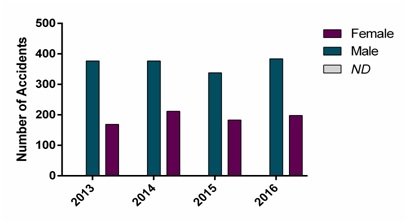
Regarding the animals responsible for envenomings there were a significant predominance (p<0.05) of snakebites (2013-351, 2014-332, 2015-331, and 2016-326 cases) in comparison to other venomous animals. On the other hand, accidents triggered by scorpions appear in second position with more modest numbers than snakes (2013-62, 2014-80, 2015-81, and 2016-102 cases), followed by bees (2013-52, 2014-66, 2015-48, and 2016-81 cases), spiders (2013-22, 2014-27, 2015-23, and 2016-30 cases), and caterpillars (2013-9, 2014-11, 2015-4, and 2016-13 cases) (Table 2). In respect to snakes genera, Bothrops genus presented the highest number of envenomings (2013-247, 2014-233, 2015-119, and 2016-233 cases), followed by Crotalus (2013-34, 2014-22, 2015-26 and 2016-326 cases), Lachesis (2013-33, 2014-29, 2015-15 and 2016-22 cases), and Micrurus genera (2013-1, 2014-3, 2015-2 and 2016-4 cases) (Figure 4). Nevertheless, the statistical significance (p<0.05) was only observed between Bothrops, Micrurus, and non-venomous snakes. It is important to emphasize that in a high number of accidents the snake genus was not determined (unknown).
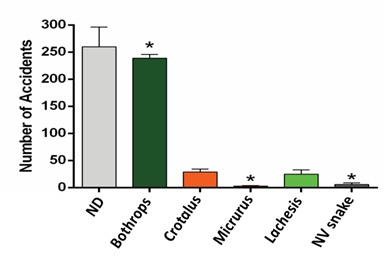
|
Accidentyear |
Snake |
Spider |
Scorpion |
Caterpillar |
Bees |
Others |
ND |
Total |
|
2013 |
351 |
22 |
62 |
9 |
52 |
36 |
14 |
546 |
|
2014 |
332 |
27 |
80 |
11 |
66 |
53 |
20 |
589 |
|
2015 |
331 |
23 |
81 |
4 |
48 |
32 |
2 |
521 |
|
2016 |
326 |
30 |
102 |
13 |
81 |
23 |
8 |
583 |
|
TOTAL |
1,340a |
102b |
325c |
37b |
247c |
144b |
44 |
2,239 |
Data was analyzed by ANOVA followed by Tukey’s post hoc test. Values of pND means not determined.
The time between accident and medical care (antivenom therapy) was also evaluated. After excluding cases in which the venomous animal was not identified, a total of 1,319 (72.71%) victims were treated in less than 6 hours after the accident, meanwhile low number of victims were treated with more than 6 hours (21.3%) (Table 3). Interestingly, the statistical analysis demonstrated that ophidian accidents are associated with 78% of patients that received therapeutic intervention after 6 hours of the accident. On the other hand, accidents caused by spiders are associated with 6.2% of patients that received therapeutic intervention after 6 hours of the accident.
|
Venomous Animal |
0-6 Hours |
6-24+ Hours |
ND |
Total |
|
Snake |
775 |
373 |
194 |
1,342a |
|
Spider |
52 |
30 |
20 |
102a |
|
Scorpion |
232 |
26 |
67 |
325b |
|
Caterpillar |
24 |
2 |
11 |
37b |
|
Bee |
147 |
28 |
72 |
247b |
|
Others |
89 |
17 |
37 |
143b |
|
Unknown |
17 |
2 |
24 |
43 |
|
TOTAL |
1,336 |
478 |
425 |
2,239 |
The victims’ envenoming severity was also explored in this study. The analysis of all the reported cases (including those 198 cases where the severity was not stratified) reveals that 1,280 envenomings (57.1%) were classified as mild, 597 (26.6%) as moderate, and 164 (7.3%) as severe (Table 4). Notably, ophidian envenomings are high associated to the development of moderate pathological manifestations in victims, while other animals are associated to progress as mild envenomings (p<0.05).
|
Venomous Animal |
Mild |
Moderate |
Severe |
ND |
Total |
|
Snake |
576 |
510* |
157* |
99 |
1342 |
|
Spider |
76 |
14 |
2 |
10 |
102 |
|
Scorpion |
272 |
26 |
2 |
25 |
325 |
|
Caterpillar |
29 |
2 |
- |
6 |
37 |
|
Bee |
205 |
27* |
- |
15 |
247 |
|
Others |
110 |
16* |
2 |
14 |
144 |
|
Unknown |
12 |
2 |
1 |
29 |
44 |
|
TOTAL |
1,280 |
597 |
164 |
198 |
2,239 |
*Indicates statistical difference (p<0.05) in comparison to the same venomous animal in the mild group. ND means not determined. Clinical severity of envenoming (mild, moderate, or severe) was classified according to the Brazilian Health Ministry guidelines.
This peculiar distribution might be better observed once the cases are described as percentages, in which mild accidents represent 42.9% of the ophidian accidents. In addition, besides snakes present the highest number of moderate envenomings, they are also responsible to the most severe ones. For instance, the evaluation regarding type of accident and envenoming severity demonstrated that only ophidian accidents present a distinctive pattern of clinical evolution comparing to all analyzed peers. Meanwhile the specific statistical study demonstrated that, in exception to snakes, the other envenomings are prone to affect Roraima victims under the same clinical evolution since mild envenomings prevailed in spiders (74.5%), scorpions (83.6%), caterpillars (78.3%), and bees (82.9%).
Finally, the study of envenoming evolution, that is cure or death, reveals that 84.7% of victims evolved to cure, although 14.7% did not have their evolution registered (Figure 5A). Despite the high number of accidents in the state of Roraima, evolution to deaths is rare, and in the analyzed period there were only 9 deaths reported (2013-2, 2014-2, 2015-1, and 2016-4 deaths). Remarkably, 8 of the registered deaths were caused by snakebites (6 caused by Bothrops, 1 by Crotalus, and 1 by Micrurus) and one by another venomous animal genus (not mentioned in the database) (Figure 5B). Therefore, the presented panel suggests that, despite the accidents severity, time intervention of treatment is capable of preventing death in most of the envenomings in Roraima, leading to a very low lethality rate (0.004%).
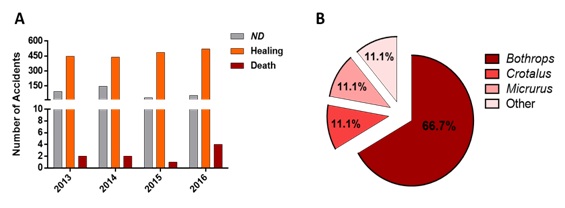 Figure 5: (A) Roraima envenoming evolution (cure versus deaths) (2013-2016); (B) Snakebite lethality distribution according to snake genus (2013-2016). ND means not determined. This figure is in color in the electronic version.
Figure 5: (A) Roraima envenoming evolution (cure versus deaths) (2013-2016); (B) Snakebite lethality distribution according to snake genus (2013-2016). ND means not determined. This figure is in color in the electronic version.DISCUSSION
The present study analyzed epidemiological information on envenomings caused by venomous animals in Roraima state, the northernmost state of Brazil, with most of its area comprised of exuberant Amazonian rainforest sheltering ample biodiversity in almost all of its territory, similar to other Brazilian states of the North region [12,21]. Therefore, these factors express a great risk for the occurrence of envenomings, which possibly justifies the Amazon region having the highest incidence of ophidian accidents [14].
The number of envenomings caused by venomous animals in Roraima during the period 2013-2016 is low (less than 0.33%) compared to the numbers registered in Brazil (2013-159,597, 2014-168,399, 2015-172,014, and 2016-172,412) [22]. It is interesting to mention that in 2015, in the state of Roraima, there was a decrease in reported accidents. This occurrence could be a reflection of national public strategies to control these accidents such as:
i. Campaign to aware the population to avoid certain environments during rainy season, a season where snakes and other venomous animals usually leave their nests and invade urban areas [23-25];
ii. Propagation of the use of PPE (Personal Protection Equipment) to workers in specific areas, such as forests, open field, civil construction, and many others [26,27];
iii. Underreporting, incomplete registration, or omissions in data collection [16,18].
The distribution of accidents among municipalities reveals the highest number of notifications in Boa Vista, which was expected, since the capital presents most of the population of Roraima (63.5%), as well as concentrates the main health reference centers such as the General Hospital of Roraima (HGR, Hospital Geral de Roraima Rubens de Souza Bento) and the Children's Emergency Service (HCSA, Hospital da Criança Santo Antonio), besides the capital presenting the most health professionals trained to effectively report envenomings accidents compared to smaller municipalities. However, other municipalities such as Amajari, Mucajaí, Uiramutã, and Rorainópolis also present relevant contribution. These municipalities are located in forest boundaries, which could explain the high incidence of envenoming within venomous animals [21,28,29].
Regarding gender, it was reported highest number of envenomings with men in all age groups, especially males between 20 and 39 years old. This immediately suggests that accidents occur in economically active individuals and outside the home environment, probably due to working conditions that expose them to such risk (such as farming, hunting, etc) [30], which was previously observed [31-33]. Furthermore, this finding is in agreement with the national data [18,34].
Looking into the animal genera responsible for envenomings in Roraima, snakes predominated with nearly 60% of all accidents, which were especially caused by Bothrops (popular name jararaca) and Crotalus (rattlesnake, popular name cascavél) genera, which results can be supported by other studies [35,36]. The snakebite predominance can be justified by the fact that snakes have considerable preference for environments that are prone to rodent proliferation (e.g storehouses, barns, and rubble), located inside forests or surrounding forests, a very common places in the municipalities of Roraima [21,37-40]. Regarding rattlesnakes envenomings in the state, it is important to emphasize the Crotalus durissus ruruima species, which in Brazil can be found just in Roraima (although they habit southern Venezuela) [41]. Besides presenting particular components and high individual variation [42], the main problem is that C.d. ruruima venom is not used to produce anticrotalic antivenom in Brazil (horses are immunized with C.d. terrificus and C.d. collilineatus venoms, 50% of each) [43,44]. Indeed, antivenomic studies demonstrated that C.d. ruruima venom is not well recognized and neutralized by the Brazilian rattlesnake antivenom, recommending the use of botropic-crotalic antivenom for therapeutics of victims [41].
The scorpion envenomings reach the second position, being responsible for 14.51% of the total number of accidents in Roraima. Our findings differ from the epidemiological data from most of Brazilian states, such as São Paulo and Minas Gerais, where scorpionism leads [17,45,46]. One possible justification is the absence of Tityus serrulatus scorpion in Roraima, which is the species mainly responsible for the high scorpionism incidence in the country. In addition, Roraima presents low urbanized areas (i.e less populated state of Brazil), which results to lowland areas favorable to scorpion proliferation due to the low accumulation of debris, garbage, and insects [47].
During 2013 to 2016, 50.95% of the victims were treated in less than 6 hours after the accident, which suggest a positive scenario since only 7.42% of the envenomings were considered severe. Clinical severity of envenoming (mild, moderate, or severe) was classified according to the Brazilian Health Ministry guidelines [48]. Other study also analyzed the time interval in receiving assistance in Rondônia (other Amazon state), in which the time between the snakebite and arrival at the hospital was higher than 6 hours in 72.7% of patients [49]. According to studies conducted in the last 100 years in Brazil, the main challenge of treating envenoming patients is the delayed care, which will result in severe envenoming and difficulties to control venom effects into patient efficiently [18,50,51]. Thus, for the best prognosis and reduction of venom induced-sequelae, it is recommended that the victims are treated in the first 6 hours after the accident [50], which emphasizes that in Roraima state the envenomings are, in most of cases, being treated with less time delay. Notably, scorpions and caterpillars envenomings resulted in the earliest care (less than 1 hour), possibly because most of them occurred in urban areas, where access to treatment can be established earlier [28,52,53].
Although most of snakebites data were registered in Boa Vista, several happened in peripheric and/or rural areas, nearby cities, or even in Indian communities. Thus, a delay in the treatment is expected based on the distance from origin of the accident and the hospital. Moreover, Roraima habitants keep some traditional culture to treat envenomings and, in many cases, victims only look for properly medical care after using traditional medicines instead [54]. Indeed, a recent study demonstrated that only few native Indians were registered as having received treatment in Brazilian Amazon (6.88%) [33].
Despite the considerable number of accidents in Roraima state, evolution to deaths is rare, and in the analyzed period there were only 9 deaths (2013-2, 2014-2, 2015-1, and 2016-4 deaths). Out of the nine deaths, eight were caused by snakes, 75% affected by Bothrops, 12.5% by Crotalus, and 12.5% by Micrurusgenera. Nevertheless, deaths from snakebites are known to be under-reported in the surveillance systems, which are estimated to be around 30% [55].
Beyond Brazil, other underdeveloped countries have also demonstrated high envenomings incidence within different numbers of mortality [56]. In Kenya, snakebites are considered a silent public health problem, presenting individual incidence between 2.7 to 6.7 per 100,000 inhabitants per year and 2.27% of mortality [57]. Although the country lacks a surveillance system to measure the incidence of snakebites, the Northern region of Cameroon presents 200 snakebites per 100,000 inhabitants [58]. In Costa Rica, there are reported 2 to 19 snakebite cases per 100,000 population per year [59]. On the other hand, Nigeria presents even higher snakebite incidence reaching 497 cases per 100,000 population per year and 12% of mortality. The high mortality in Nigeria can be explained by de low medical assistance, since only 8.5% of snakebite victims attend hospitals in Nigeria [60]. Unlike underdeveloped countries, snakebite envenomings in developed countries are lower, as can be evidenced by Switzerland [61], France and Germany [62], Czech Republic [63], and USA [64-66]. Thus, a more detailed analysis of envenomings in underdeveloped countries is required, in order to design interventions that could reduce the impact of the public health problem in these countries.
CONCLUSION
ACKNOWLEDGEMENT
REFERENCES
- Gutiérrez JM, Theakston RD, Warrell DA (2006) Confronting the neglected problem of snake bite envenoming: The need for a global partnership. PLoS Med 3: 150.
- de Souza W (2010) Doenças Rio de Janeiro.
- Molyneux D (2013) Neglected tropical diseases. Community Eye Health 26: 21-24.
- WHO (2019) Snakebite envenoming-A strategy for prevention and control.
- Chippaux JP (2015) Epidemiology of envenomations by terrestrial venomous animals in Brazil based on case reporting: From obvious facts to contingencies. J Venom Anim Toxins incl Trop Dis 21.
- Pucca MB, Oliveira F, Schwartz EF, Arantes EC, Lira-da-Silva RM (2014) Scorpionism and dangerous species of Brazil. Toxinology 1-24.
- Bochner R, Fiszon JT, Machado C (2014) A profile of snake bites in brazil, 2001 to 2012. J Clin Toxicol 4: 194.
- Pimenta RJG, Brandão-Dias PFP, Leal HG, Carmo AOD, Oliveira-Mendes BBR, et al. (2019) Selected to survive and kill: Tityus serrulatus, the Brazilian yellow scorpion. PLoS One 14: 0214075.
- Chippaux JP (2009) [Impact of the environment on envenomation incidence and severity]. Med Sci (Paris) 25: 858-862.
- Machado C (2016) Um panorama dos acidentes por animais peçonhentos no Brasil/An overview of accidents involving venomous animals in Brazil/Un panorama de los accidentes por animales venenosos en Brasil. Journal Health NPEPS 1.
- Cardoso JLC (1993) Acidentes por Animais Peçonhentos na Coordenação de Zoonoses e Animais Peçonhentos-Comentários e Sugestões. Brasília: Ministério da Saúd
- Leobas GF, Seibert CS, Feitosa SB (2016) Acidentes por animais peçonhentos no Estado do Tocantins: Aspectos clínico-epidemiológ DESAFIOS 2: 269-282.
- Chapin FS, Sala OE, Huber-Sannwald E (2013) Global Biodiversity in a Changing Environment: Scenarios for the 21st Century. Springer Science & Business Media, Berlin, Germany.
- Bernarde PS, Gomes JDO (2012) Serpentes peçonhentas e ofidismo em Cruzeiro do Sul, Alto Juruá, Estado do Acre, Brasil. Acta Amazonica 42: 65-72.
- Needleman RK, Neylan IP, Erickson T (2018) Potential environmental and ecological effects of global climate change on venomous terrestrial species in the wilderness. Wilderness Environ Med 29: 226-238.
- Fiszon JT, Bochner R (2008) Subnotificação de acidentes por animais peçonhentos registrados pelo SINAN no Estado do Rio de Janeiro no período de 2001 a 2005. Revista Brasileira de Epidemiologia 11: 114-127.
- Brasil MS (2015) Análise dos dados epidemiológicos de 2010-2014. Ministério da sáude-Portal da Saúde.
- Bochner R, Struchiner CJ (2003) Epidemiologia dos acidentes ofídicos nos últimos 100 anos no Brasil: uma revisão. Cad Saúde Pública
- Fetherston T (2015) The importance of critical incident reporting-and how to do it. Community Eye Health 28: 26-27.
- Moloo A (2019) WHO launches global strategy for prevention and control of snakebite envenoming.
- Nascimento SP (2000) [Epidemiological characteristics of snakebites in the state of Roraima, Brazil, 1992-1998]. Cad Saude Publica 16: 271-276.
- SINAN (2019) Accident by Venomous Animals.
- Henderson RW, Hoevers LG (1977) The seasonal incidence of snakes at a locality in northern Belize. Copeia 1977: 349-355.
- Punde DP (2005) Management of snake-bite in rural Maharashtra: A 10-year experience. Natl Med J India 18: 71-75.
- Fry BG (2018) Snakebite: When the human touch becomes a bad touch. Toxins (Basel) 10: 170.
- Sawada SI, Kuklane K, Wakatsuki K, Morikawa H (2017) New development of research on Personal Protective Equipment (PPE) for occupational safety and health. Ind Health 55: 471-472.
- Torp S, Grøgaard JB, Moen BE, Bråtveit M (2005) The impact of social and organizational factors on workers' use of personal protective equipment: A multilevel approach. J Occup Environ Med 47: 829-837.
- dos Santos MC (1995) Serpentes de interesse médico da Amazônia: biologia, venenos e tratamento de acidentes. Universidade Do Amazonas, Amazonas, Brazil.
- Barraviera B, Júnior RSF (2015) Acidentes ofídicos. In: Atheneu (ed.). Veronesi: Tratado de infectologia. Pg no: 2350-2367.
- Leynaud GC, Reati GJ (2009) Identifying areas of high risk for ophidism in Cordoba, Argentina, using SIGEpi software. Rev Panam Salud Publica 26: 64-69.
- Feitosa ES, Sampaio V, Sachett J, Castro DB, Noronha Md, et al. (2015) Snakebites as a largely neglected problem in the Brazilian Amazon: Highlights of the epidemiological trends in the State of Amazonas. Rev Soc Bras Med Trop 1: 34-41.
- Abreu CB, Medeiros JM, Souza WMP, Cerni FA, Pereira UZ, et al. (2017) Epidemiological profile of accidents caused by venomous animals in Amazonas state. Health and Diversity 1: 96-103.
- Magalhães SFV, Peixoto HM, Moura N, Monteiro WM, de Oliveira MRF (2019) Snakebite envenomation in the Brazilian Amazon: A descriptive study. Trans R Soc Trop Med Hyg 113: 143-151.
- Malaque CMS (2014) Acidentes por animais peçonhentos. Hospital Vital Brazil Instituto Butantan, São Paulo, Brazil.
- Loren Rebouças Santos H, Diego de Brito Sousa J, Arthur Alcântara J, de Almeida Gonçalves Sachett J, Soares Villas Boas T, et al. (2019) Rattlesnakes bites in the Brazilian Amazon: Clinical epidemiology, spatial distribution and ecological determinants. Acta Trop 191: 69-76.
- Waldez F, Vogt RC (2009) Aspectos ecológicos e epidemiológicos de acidentes ofidicos em comunidades ribeirinhas do baixo rio Purus, Amazonas, Brasil. Acta Amazonica 39: 681-692.
- Veronesi R, Focaccia R (2016) Tratado De Infectologia-2 Volumes. Editora Atheneu, São Paulo, Brazil.
- Bernarde PS (2014) Serpentes Peçonhentas: E Acidentes Ofídicos No Brasil. Anolis Books Editora, São Paulo,
- Coser A, Wolff I, de Quadros RM, Marques SMT (2015) Acidentes ofídicos nas mesorregiões do estado de Santa Catarina. Revista de Ciências Médicas e Biológicas 14: 14-21.
- Yañez-Arenas C, Díaz-Gamboa L, Patrón-Rivero C, López-Reyes K, Chiappa-Carrara X (2018) Estimating geographic patterns of ophidism risk in Ecuador. Neotropical Biodiversity 4: 55-61.
- Dos Santos MC, Ferreira LCL, Da Silva WD, Maria de Fátima DF (1993) Caracterizacion de las actividades biologicas de los venenos ‘amarillo’ y ‘blanco’ de Crotalus durissus ruruima comparados con el veneno de Crotalus durissus terrificus. Poder neutralizante de los antivenenos frente a los venenos de Crotalus durissus ruruima. Toxicon 31: 1459-1469.
- Dos-Santos MC, Assis EB, Moreira TD, Pinheiro J, Fortes-Dias CL (2005) Individual venom variability in Crotalus durissus ruruima snakes, a subspecies of Crotalus durissus from the Amazonian region. Toxicon 46: 958-961.
- Wen FH, Monteiro WM, Silva AMM, Tambourgi DV, da Silva IM, et al. (2015) Snakebites and scorpion stings in the Brazilian Amazon: Identifying research priorities for a largely neglected problem. PLoS Negl Trop Dis 9: 0003701.
- Oliveira IS, Pucca MB, Sampaio SV, Arantes EC (2018) Antivenomic approach of different Crotalus durissus collilineatus venoms. J Venom Anim Toxins Incl Trop Dis 24: 34.
- Reckziegel GC, Junior VLP (2014) Análise do escorpionismo no Brasil no período de 2000 a 2010. Rev Pan-Amaz Saude.
- Pardal PPdO, Gadelha MAdC, Menezes MMGO, Malheiros RS, Ishikawa EAY, et al. (2014) Envenenamento grave pelo escorpião Tityus obscurus Gervais, 1843. Revista Pan-Amazônica de Saúde 5: 65-70.
- Pucca MB, Oliveira FN, Schwartz EF, Lira-da-Silva RM (2015) Scorpionism and Dangerous Species of Brazil Scorpion Venoms Gopalakrishnakone. Springer Reference 2015: 299-324
- Acidentes por Animais Peçonhentos e Venenosos.
- Roriz KRPS, Zaqueo KD, Setubal SS, Katsuragawa TH, Silva RRD, et al. (2018) Epidemiological study of snakebite cases in Brazilian Western Amazonia. Rev Soc Bras Med Trop 51: 338-346.
- FUNASA (2001) Manual de diagnóstico e tratamento de acidentes por animais peço Ministério da Saúde, Fundação Nacional de Saúde.
- Sheikhtaheri A (2014) Near misses and their importance for improving patient safety. Iran J Public Health 43: 853-854.
- Sharma SK, Bovier P, Jha N, Alirol E, Loutan L, et al. (2013) Effectiveness of rapid transport of victims and community health education on snake bite fatalities in rural Nepal. Am J Trop Med Hyg 89: 145-150.
- Rechel B, Džakula A, Duran A, Fattore G, Edwards N, et al. (2016) Hospitals in rural or remote areas: An exploratory review of policies in 8 high-income countries. Health Policy 120: 758-769.
- Chippaux JP (2017) Snakebite envenomation turns again into a neglected tropical disease! J Venom Anim Toxins Incl Trop Dis 23: 38.
- da Silva Souza A, de Almeida Gonçalves Sachett J, Alcântara JA, Freire M, Alecrim MDGC, et al. (2018) Snakebites as cause of deaths in the Western Brazilian Amazon: Why and who dies? Deaths from snakebites in the Amazon. Toxicon 145: 15-24.
- Kaushik M, Banyal V, Sondhi S, Thakur MK, Kaushik A (2018) Clinical profile of snake bite patients in tertiaty care hospital in Himachal Pradesh: A prospective study. International Journal of Research in Medical Sciences 6: 2444-2448.
- Ochola FO, Okumu MO, Muchemi GM, Mbaria JM, Gikunju JK (2018) Epidemiology of snake bites in selected areas of Kenya. Pan Afr Med J 29: 217.
- Chippaux JP, Rage-Andrieux V, Le Mener-Delore V, Charronrière M, Sagot P, et al. (2002) Epidémiologie des envenimations ophidiennes dans le nord du Cameroun. Bull Soc Pathol Exot 95: 184-187.
- Sasa M, Vazquez S (2003) Snakebite envenomation in Costa Rica: A revision of incidence in the decade 1990-2000. Toxicon 41: 19-22.
- Habib AG, Gebi UI, Onyemelukwe GC (2001) Snake bite in Nigeria. Afr J Med Med Sci 30: 171-178.
- Plate A, Kupferschmidt H, Schneemann M (2016) [Bites of venomous snakes in Switzerland]. Praxis (Bern 1994) 105: 679-685.
- Schaper A, Desel H, Ebbecke M, De Haro L, Deters M, et al. (2009) Bites and stings by exotic pets in Europe: An 11 year analysis of 404 cases from Northeastern Germany and Southeastern France. Clin Toxicol (Phila) 47: 39-43.
- Valenta J, Stach Z, Michalek P (2014) Exotic snake bites in the Czech Republic--Epidemiological and clinical aspects during 15-year period (1999-2013). Clin Toxicol (Phila) 52: 258-264.
- Parrish HM (1966) Incidence of treated snakebites in the United States. Public Health Rep 81: 269-276.
- O'Neil ME, Mack KA, Gilchrist J, Wozniak EJ (2007) Snakebite injuries treated in United States emergency departments, 2001-2004. Wilderness Environ Med 18: 281-287.
- Othong R, Sheikh S, Alruwaili N, Gorodetsky R, Morgan BW, et al. (2012) Exotic venomous snakebite drill. Clin Toxicol (Phila) 50: 490-496.
Citation: Souza WMP, Silva GA, Cerni FA, de Oliveira IS, Zottich U, et al. (2019) Envenomings Caused by Venomous Animals in Roraima: A Neglected Health Problem in the Brazil’s Northernmost State. J Toxicol Cur Res 3: 011.
Copyright: © 2019 Wállex Matias Pedroso Souza, et al. This is an open-access article distributed under the terms of the Creative Commons Attribution License, which permits unrestricted use, distribution, and reproduction in any medium, provided the original author and source are credited.

